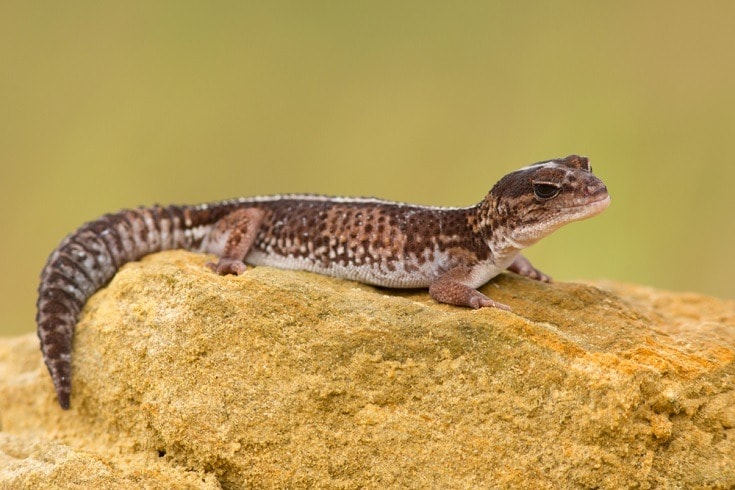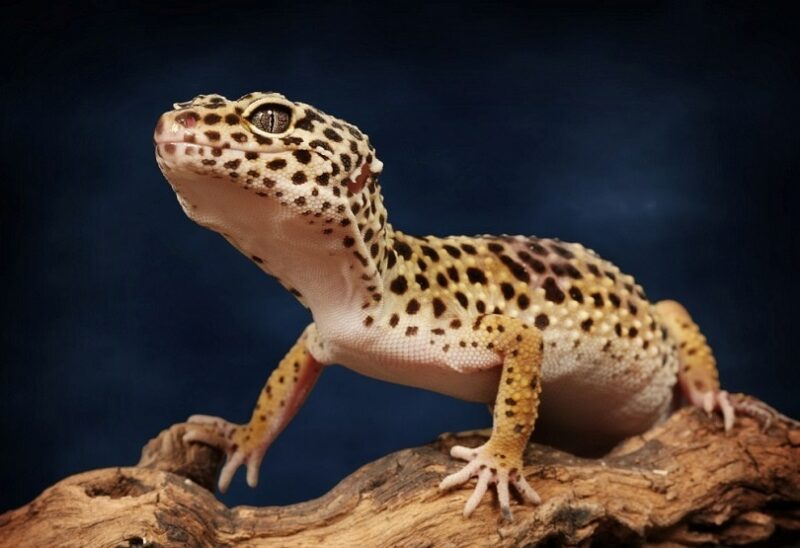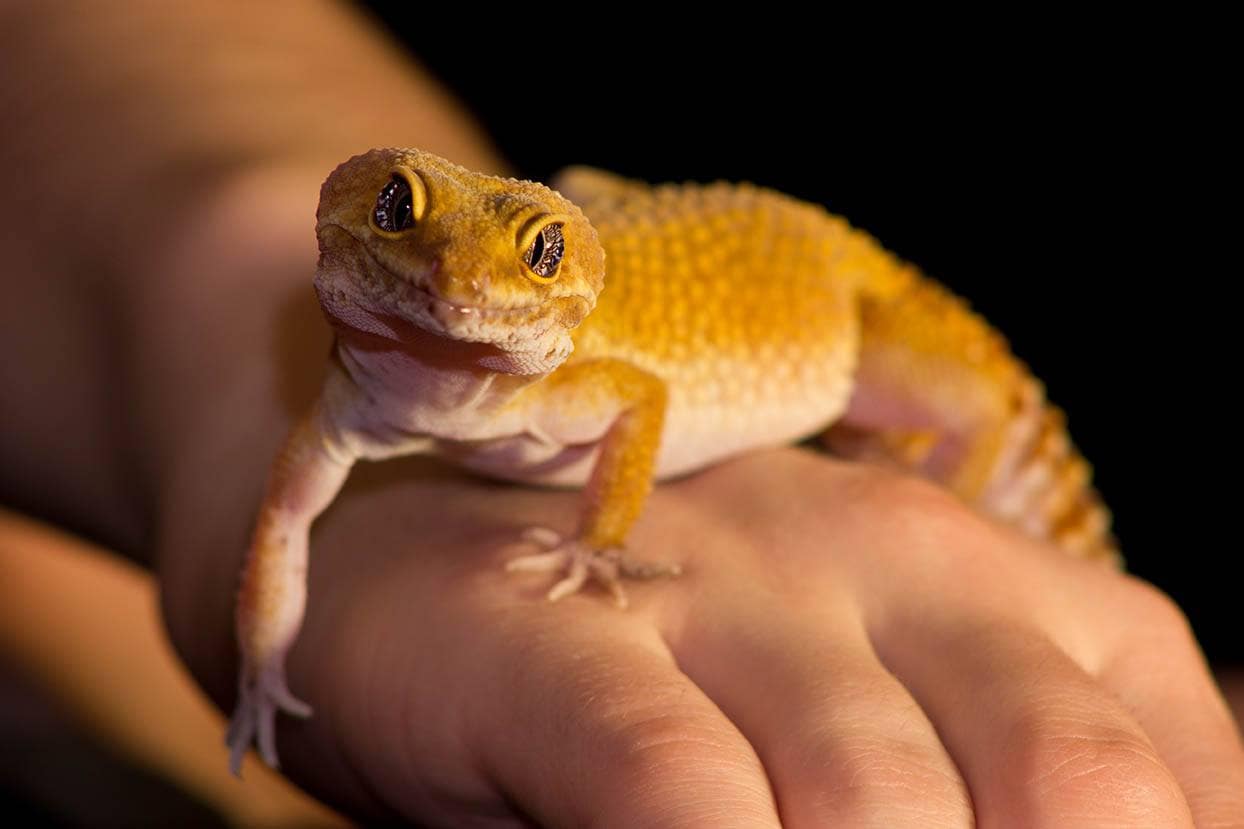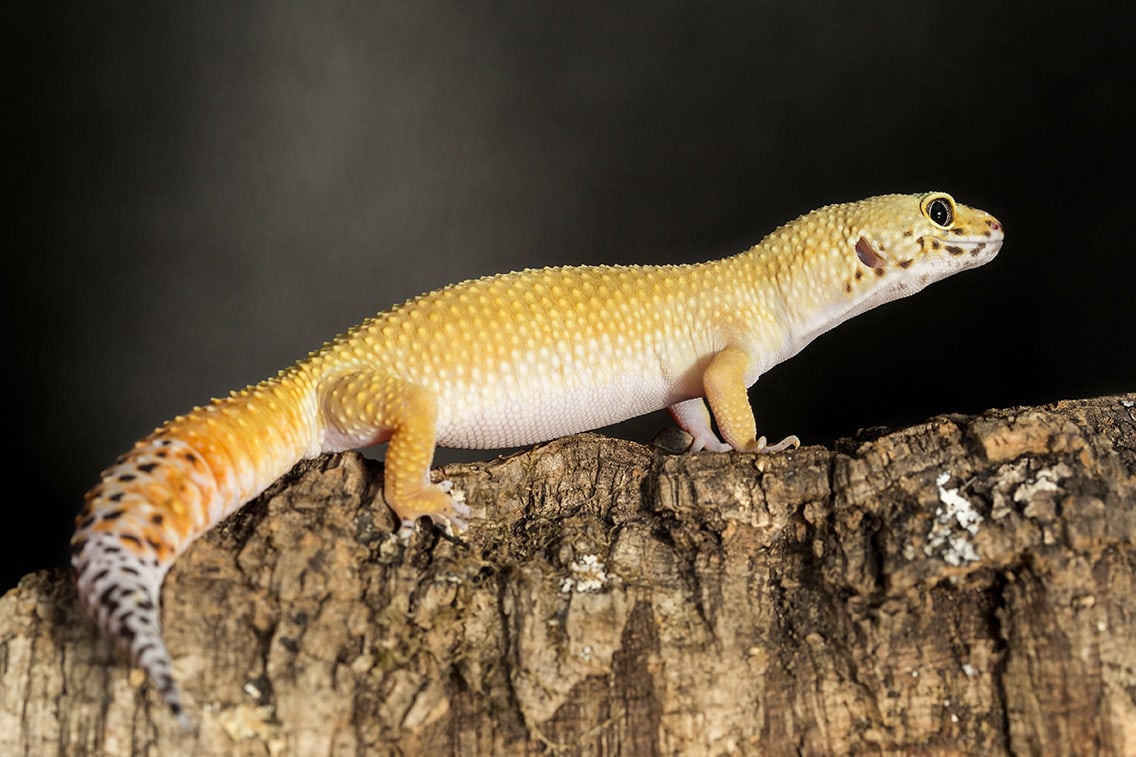
Are you looking to become a gecko parent? If so, you should consider an African fat-tailed Gecko! They’re an excellent gecko breed for first-time or novice gecko owners as they are hardy and have fewer needs than other species.
Let’s take a detailed look into this unique reptile and see just how amazing they actually are.

Quick Facts about the African Fat-Tailed Gecko

| Species Name: | Hemitheconyx caudicinctus |
| Family: | Eublepharidae |
| Care Level: | Novice |
| Temperature: | 80° F (cool side), 90°-95° F (hot side) |
| Temperament: | Calm, docile |
| Color Form: | Light brown or beige base with darker bands or stripes |
| Lifespan: | 10-25 years |
| Size: | 7-9 inches long, weighing between 1.5-2.6 ounces |
| Diet: | Insects |
| Minimum Tank Size: | 10-gallon minimum |
| Tank Set-Up: | Terrestrial wooden vivarium |
| Compatibility: | Males should be housed alone or with other females |
African Fat-Tailed Gecko Overview
The African fat-tailed gecko is a terrestrial gecko originating from the savannahs and plains of West African deserts. They’re ground dwellers, which means that they don’t live in trees and spend their lives running through the dust and dirt. This helps to explain why they have thick moveable eyelids like their cousins, the leopard gecko.
These lizards derive their name from their fat, bulbous tails. Their tails serve as a place for the gecko to store extra fat in case of calorie deficit. However, they can quickly shed their tails through an act called caudal autonomy. This is done when the gecko becomes threatened or vulnerable. It helps them to move faster or escape the clutches of a hungry predator.
Because they naturally live in very dry environments, African fat-tailed geckos are commonly found in humid hidey-holes near river edges. However, they will come out to bask—like any other cold-blooded animal—on a sunny rock during the day.
How Much Do African Fat-Tailed Geckos Cost?
When shopping for an African fat-tailed gecko, you’re going to find a wide price range. Typically, they range from $75 to $500. This price range depends on primarily two things: appearance and breeder.
Rare color morphs tend to go for much higher prices than their typical colorways. Also, a trusted breeder will often charge more per gecko. You won’t normally find these lizards at your local pet shop; however, there are plenty of breeders available online.
Shopping online for your gecko can be a very convenient process as it allows you to be much more selective about your African fat-tailed gecko’s appearance and breeding history.

Typical Behavior & Temperament

Many gecko species are rather aggressive and fall under the adage, “look, but don’t touch.” Such is not the case with the African fat-tailed gecko. While it’s uncertain whether they enjoy being held and handled, they certainly don’t seem to mind it as much as other geckos do.
They are rather docile and remain calm when in neutral surroundings. You’ll often find them hiding within the logs and shades in their habitats during the day or sunning themselves on a basking stone. However, nighttime is a different story. They are a nocturnal breed and become more active at night. This is when they prefer to hunt, so feeding them may be best during the evening hours.
Males are generally the more vocal of the sexes using a series of clicks and squeaks to claim territory, warn off other males, and even to attract breeding females. Females typically only vocalize when threatened. However, you may find your African fat-tailed gecko communicating through its tail. They will wag, stiffen, and even rattle their tail depending on their mood.
Appearance & Varieties
The African fat-tailed gecko is born with one of two forms: banded or striped. Banded geckos have darker bands that stretch down the length of their bodies. Striped geckos have a long thin stripe running vertically down their length from tip to tail.
The natural color pattern of the gecko is a beige or light brown base with darker brown stripes. However, through selective breeding, many different morphs have emerged. You can now find different colors such as bright orange, black and white, albino, and many more.

How to Take Care of African Fat-Tailed Geckos
Habitat Conditions & Setup

When constructing your African fat-tailed gecko’s habitat, you’ll want to take the wooden vivarium approach. They act as great insulators to keep your gecko nice and toasty. However, you should ensure that there is still airflow. Your vivarium should have vents that promote this.
Also, since they won’t grow too much, you can start with and maintain your gecko’s tank at 10 gallons. However, if you intend on breeding them or keeping multiple geckos in the same enclosure, we recommend that each gecko has a minimum of 10 gallons. For example, if you have two adults, you should keep them in a 20-gallon tank and so forth.
Your African fat-tailed gecko should also receive a full 12 hours of light each day. However, they don’t really need a strong UVB light. A simple T8 or T5 lamp on a timer will work just fine for them. Be sure to mount your light in the back corner as well. These lizards do enjoy hiding in the dark. A corner-mounted light can help provide this more than a center-positioned overhead bulb can.
These buggers also like it hot, and that means heating. Ideally, you want to avoid under-substrate heaters as they may burn themselves on them. Instead, opt for a basking light. These will provide all the heat they need.
Speaking of the substrate, paper is the best bet for your African fat-tailed gecko, and it allows for easy spot cleaning each day. The disadvantage of paper is that it needs changing every 2-3 days. Compressed coconut bedding is also a decent choice and only needs changing weekly.
Are African Fat-Tailed Geckos Good Terrarium Mates?
One of the biggest concerns about owning multiple geckos is determining whether or not they’re going to play nice together in a singular habitat. African fat-tailed geckos are very territorial, and it’s not advised to keep two males within the same enclosure. It would be only a matter of time before they attacked each other in a show of dominance with one (or both) becoming severely injured or killed in the process.
However, you can keep a single male with other females. Just remember that this can and will lead to breeding. So, unless you’re looking to have more geckos, you may want to keep them separate.
Generally speaking, multiple females can be successfully housed in a singular habitat. They aren’t nearly as territorial as the males, but you may see one of them assert themselves as terrarium queen.
What to Feed Your African Fat-Tailed Gecko

Like most geckos, the African fat-tailed is a strict carnivore. Their diet should be 100% insect-based. While they’re not gourmands, they’ve been observed to like crickets and mealworms over other insect varieties. However, they’ve been known to consume waxworms, hornworms, silkworks, and even pinky mice!
Along with their standard fare of insects, your African fat-tailed gecko will require additional supplements—particularly if they’re adapting to a new environment. This can easily be accomplished by dusting their insects with specialized powders to give them the nutrition they require.
You should feed them strictly live prey as it encourages movement and exercise of their natural hunting instincts. But you may notice that your gecko doesn’t want to eat every night. After a big meal, they’ll store extra fat in their tails that will hold them over for a few days.
Keeping Your African Fat-Tailed Gecko Healthy
These are some relatively healthy and hardy lizards. And once established in their new homes, they do extremely well on a day-by-day basis. The riskiest time for them to fall ill is during transfer to a new habitat.
Simple daily maintenance can keep them at their best. You should spot clean their tanks and remove their feces every single day. This will minimize their chances at contracting cryptosporidiosis—a fecal-borne disease. Aside from daily spot cleanings, you should deep clean their tank at least once a month which includes a full scrub down and disinfecting.
Breeding
African fat-tailed geckos have a distinct breeding season each year that typically lasts 5 months—normally November to March. While females can lay up to five clutches of eggs in this time, most often lay much fewer with either a single or two clutches only.
Typically, females only lay two eggs at a time which measure between 1-1.5 inches long. These eggs can actually be sex-influenced during incubation through temperature. For a greater chance of hatched males, eggs should be incubated at 88°-89° F. For females, 83°-85° F is the sweet spot.
Eggs that are incubated at temperatures lower than these are considered fatal. Those incubated at higher temperatures can survive; however, these eggs have been known to produce primarily aggressive, poor breeding females.

Are African Fat-Tailed Geckos Suitable For Your Terrarium?
So, are African fat-tailed geckos right for you? If you’re searching for a lower-maintenance reptile, you’re in the right place. They’re also super-docile when compared to others and don’t mind leaving their tank to hang out every once and awhile. And since these lizards also come in several different colors and patterns, there’s bound to be one perfect out there for every gecko lover.
- You might also be interested in: Giant Leaf-Tailed Gecko
Featured Image Credit: Milan Zygmunt, Shutterstock








